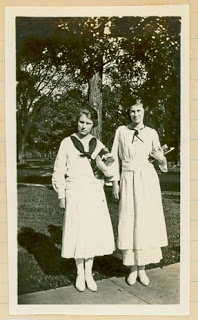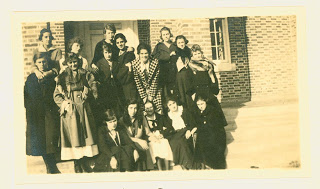For additional information about the first women students at the College of William and Mary see: When Mary Entered with her Brother William: Women at the College of William and Mary, 1918-1945 by Laura F. Parrish; "The Petticoat Invasion": Women at the College of William and Mary, 1918-1945; The Martha Barksdale Papers; and the Women at the College of William and Mary page on the Special Collections Research Center Wiki.
October 10, 2008
A Step Away from 1918-1919: Barksdale Field
For additional information about the first women students at the College of William and Mary see: When Mary Entered with her Brother William: Women at the College of William and Mary, 1918-1945 by Laura F. Parrish; "The Petticoat Invasion": Women at the College of William and Mary, 1918-1945; The Martha Barksdale Papers; and the Women at the College of William and Mary page on the Special Collections Research Center Wiki.
October 8, 2008
Student Groups for Women, 1918-1919
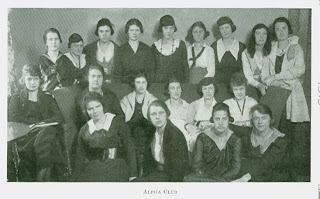 The Alpha Club was a multi-faceted organization. Headed by Celeste Ross its first year, the group sought to "develop departments of Music, Dramatics, Literary Activities, and other interests, all united in name and general purpose in the original Club."
The Alpha Club was a multi-faceted organization. Headed by Celeste Ross its first year, the group sought to "develop departments of Music, Dramatics, Literary Activities, and other interests, all united in name and general purpose in the original Club."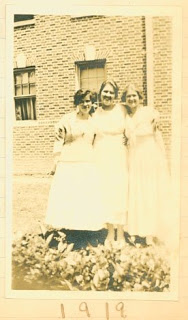 The "P.P." Club: (l-r) Martha Barksdale, Alice Burke, Catherine Dennis. From Catherine Dennis' scrapbook.
The "P.P." Club: (l-r) Martha Barksdale, Alice Burke, Catherine Dennis. From Catherine Dennis' scrapbook.This post was composed by Kate Hill.
For additional information about the first women students at the College of William and Mary see: When Mary Entered with her Brother William: Women at the College of William and Mary, 1918-1945 by Laura F. Parrish; The Martha Barksdale Papers; and the Women at the College of William and Mary page on the Special Collections Research Center Wiki.
October 3, 2008
October 1918: Changes in Williamsburg
Janet Coleman Kimbrough, Williamsburg resident as well as a member of the College's first class of women, later detailed a number of physcial and social adjustments that occured throughout the town:
We had daylight savings [time]; of course we'd never had [it] before. Automobile traffic was just really getting under way, and the army stimulated that tremendously. There were these military trucks continually coming through town carrying loads of military materials down to the ports and the army camps here. They tore up the road. We had no paved roads, you see, and we had two very bad winters, and they tore up the roads terribly and turned them into just almost an impossible morass -- especially the eastern end of Duke of Gloucester Street. You really couldn't get across it. You had to walk sometimes three or four blocks up the street before you could go from one side to another because of this deep mud. I remember stepping in and losing my shoe in it; there was no hope of finding it; it was way down in the mud. To complicate matters still further, the town decided to put in water and sewage -- or had decided just ahead of all this -- and they dug the street up to put in sewer pipes, and that made it that much worse. They began the thing thinking they were going to be able to finish it quickly and then because of the shortage of materials and shortage of labor and so forth, it didn't get finished as quickly as they thought. The result was that the streets were terribly torn up. Of course, the fact that almost every family had some member involved in the armed forces -- there was just so much change at that time that coeducation was a minor matter. Girls' skirts were going up; of course, the flapper and jazz and the type of dancing -- everything was "upsetting the morals and the morality of the young people," and we were coming in for a great deal of criticism. Just everything was changing; the coeducation was just one small item, really.
The above oral history excerpts are from interviews with Emily Williams, as part of an oral history project of the College conducted between 1974 and 1976. A longer excerpt of Kimbrough's interview may be found online. Catherine Dennis' scrapbook is available in the Special Collections Research Center. Taps, a booklet commemorating the Students' Army Training Corps, is available for viewing online.
September 25, 2008
September 25 - October 5, 1918: Quarantine
Further reports of the influenza epidemic (commonly known as the "Spanish flu") in Williamsburg in the Gazette are sparse, but the October 3 edition of the newspaper did note that the dance hall at the Marx Hotel had closed to help prevent the spread of the disease, and encouraged other businesses in the area to do the same. On campus, classes were cancelled during the quarantine.
Martha Barksdale, one of the first women students, mentioned the quarantine in her diary entry of November 26 and that none of the women in Tyler Hall were ill. New to the dormitory and college life, they used the break from classes to get to know each other, and even play a game of basketball. The quarantine period helped established Tyler as a center for activity for the female students. Although fewer than 14 members of the first group lived in the dorm, the women who lived off-campus in Williamsburg spent much of their free time there. As Janet Coleman Kimbrough described in an interview, "we were tremendously interested in each other [...] We spent a great deal of time discussing clothes and manners and what everybody was doing and whether to use lipstick or not and whether a girl who kissed boy was fast and so forth."
The students afflicted with the disease eventually recovered and the campus quarantine was lifted on October 5. Classes resumed, and the students returned to work.
Middle row, l-r: Janet Coleman, Marie Wilkins, Louise Reid, Martha Barksdale, Margaret Lee
An excerpt of Janet Coleman Kimbrough's interview is featured in the online exhibit, "The Petticoat Invasion": Women at the College of William and Mary, 1918-1945. Full text of Kimbrough's interview, issues of The Virginia Gazette, and Catherine Dennis' scrapbook are available in the Special Collections Research Center.
This post was composed by Kate Hill.
September 19, 2008
September 19, 1918: A New W. & M. Begins Two Hundred Twenty-Sixth Year
 In a front page news story, the paper referred to a "new atmosphere" at the opening of the session. The paper went on to say that along with the usual atmosphere surrounding the new semester also came the "gentle women of Virginia to drink at the same fountainhead of learning from whose waters the famous of the land have quaffed. It is a momentous event in the history of this grand old institution, and a strange coincidence that the inception of the military should be smultaneous (sic) with the coming of the women of the land."
In a front page news story, the paper referred to a "new atmosphere" at the opening of the session. The paper went on to say that along with the usual atmosphere surrounding the new semester also came the "gentle women of Virginia to drink at the same fountainhead of learning from whose waters the famous of the land have quaffed. It is a momentous event in the history of this grand old institution, and a strange coincidence that the inception of the military should be smultaneous (sic) with the coming of the women of the land."This blog has mentioned some effects of World War I here and here, and you will be able to find all future posts on the topic here.
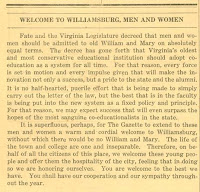
A brief article on The Gazette's editorial page welcomed women to the College and noted that their success and integration was fully anticipated. The paper's words also struck a sympathetic tone noting that the new students would have the cooperation of the paper and town of Williamsburg during the year.
For additional information about the first women students at the College of William and Mary see: When Mary Entered with her Brother William: Women at the College of William and Mary, 1918-1945 by Laura F. Parrish; "The Petticoat Invasion": Women at the College of William and Mary, 1918-1945; The Martha Barksdale Papers; and the Women at the College of William and Mary page on the Special Collections Research Center Wiki.
September 19, 1918: From the Diary of Martha Barksdale
For additional information about the first women students at the College of William and Mary see: When Mary Entered with her Brother William: Women at the College of William and Mary, 1918-1945 by Laura F. Parrish; "The Petticoat Invasion": Women at the College of William and Mary, 1918-1945; The Martha Barksdale Papers; and the Women at the College of William and Mary page on the Special Collections Research Center Wiki.
September 19, 1918: Mary Enters with Her Brother William
Lilian Hope Baines, Martha Barksdale, Margaret Florence Bridges, Lucille Brown, Janet Coleman, Ruth Taylor Conkey, Catherine Dennis, Mary Haile, Florence Mae Harris, Ruth Harris, Elizabeth Lee, Margaret Lee, Evelyn Palmer, Alice Person, Edna Widgen Reid, Laura Louise Reid, Celeste Ross, Elizabeth Scott, Margaret Thornton, and Marie Wilkins.
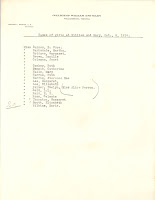 This list is from the document "Names of girls at William and Mary, Oct., 8, 1918" from the office of Herbert L. Bridges. Bridges served as Registrar and Secretary of the Faculty from 1907 until 1928 and held several other positions at the College as well during his tenure from 1881 through 1933. Click image to enlarge.
This list is from the document "Names of girls at William and Mary, Oct., 8, 1918" from the office of Herbert L. Bridges. Bridges served as Registrar and Secretary of the Faculty from 1907 until 1928 and held several other positions at the College as well during his tenure from 1881 through 1933. Click image to enlarge.
Other lists also include Alice Burke, Winifred Goodwin, Emily Hall, and Alice Powers as part of the first class of women. President Lyon G. Tyler would later refer to these women in a letter to Catherine Dennis as the "noble band of girls who broke the ice at William and Mary, and led the way in the emancipation of their sex." Still, as of September, 19, 1918, they were also just the latest in a long line of new students to College - facing the challenges of classes and a new social environment.
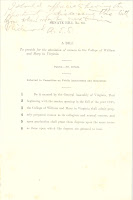 ry.
ry.A copy of the Strode Bill that allowed women to attend William and Mary from the records of President Lyon G. Tyler. Click image to enlarge.
This post was composed by Jordan Ecker and Kate Hill.
For additional information about the first women students at the College of William and Mary see: When Mary Entered with her Brother William: Women at the College of William and Mary, 1918-1945 by Laura F. Parrish; "The Petticoat Invasion": Women at the College of William and Mary, 1918-1945; The Martha Barksdale Papers; and the Women at the College of William and Mary page on the Special Collections Research Center Wiki.
